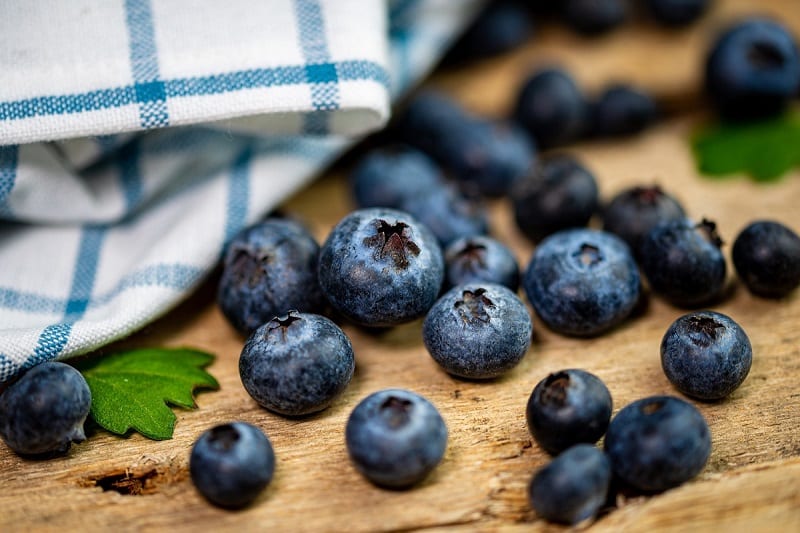
Blueberries are a favorite among backyard gardeners because they are delicious and easy to grow. Species such as the highbush blueberry and the lowbush blueberry serve a dual purpose as landscapers often use them as an ornamental ground crop.
The plants propagate reliably from fresh seed, but the resulting shrub may not closely resemble the parent plant.
How to Grow Blueberries from Seed
Contents
While some cultivars yield a good crop on their own, blueberries produce more fruit when planted near different blueberry varieties. Flowering can occur early or late in the spring, depending on the cultivar.
Here’s how to grow blueberries from seeds.
Planting the Seeds
- Fill 12-inch nursery pots with equal parts of moist milled peat, coarse sand, and loam. Sprinkle a pinch of blueberry seeds across the surface of the soil. Spread a thin layer of milled peat over the seeds.
- Place the nursery pots outdoors inside a lightly shaded cold frame. Cover each pot with a sheet of newspaper. Use a germination mat to warm the pots to no more than 20°C if daytime temperatures stay below freezing.
- Use a plant mister to keep the top inch of the soil evenly moist throughout the month-long germination period.
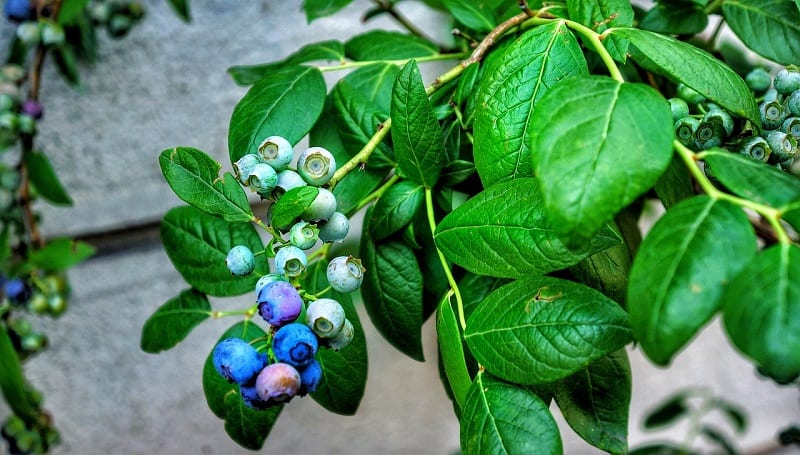
Nursing Blueberry Seedlings
- Remove the newspaper and the germination mat once the seedlings emerge. Crack open the cold frame a bit to acclimate the young plants to outdoor conditions.
- Start thinning the blueberry seedlings to two per pot once they grow to a height of about 2 inches. Keep the strongest, most vigorous of the seedlings. Snip off weaker seedlings at soil-level with a small pair of scissors.
- Move the nursery pots to a sheltered spot outdoors and water regularly, moistening the soil to a depth of one inch every week. You can transplant the blueberries the following autumn.
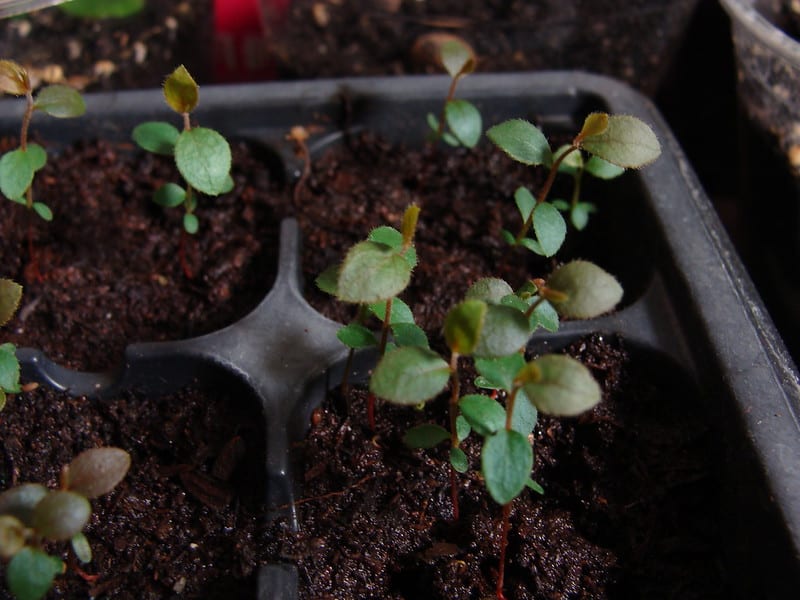
(Photo: Steve Lau/Flickr)
Selecting a Site
- Select a sunny, sheltered spot for your blueberry seedlings. Blueberries are tolerant of shade, but plants that receive some sun yield better crops.
- Blueberries flourish in soil with a pH of 4.5 to 5.5. Because most garden soil does not have this much acidity, apply a small amount of granulated sulfur to the site a few months before planting.
- Don’t plant blueberries too close to trees. The trees will not only block out sunlight, but will also compete against your blueberry bushes for moisture in the soil.
- If you are planting multiple bushes, it’s best to plant them together in a patch. This will encourage berry production and bolster the quality of their fruit.
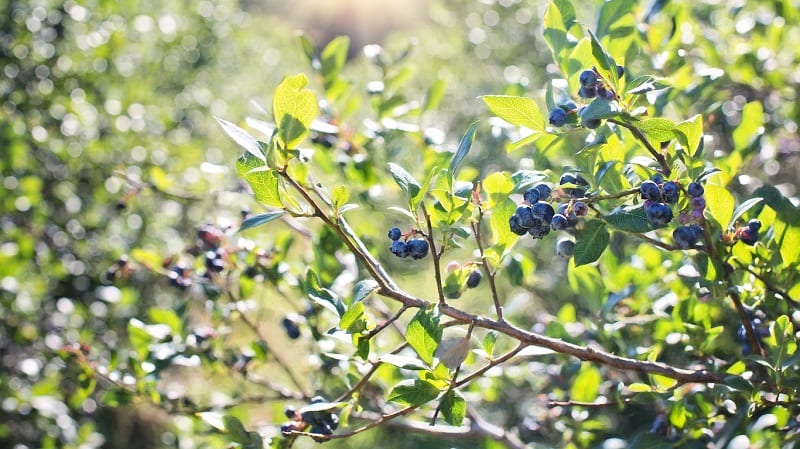
Planting Blueberries
- Dig holes about 20 inches deep and 18 inches wide for each of the seedlings. Space the bushes 5 feet apart in rows. Allow at least 8 feet between the rows.
- Prepare a planting mixture of 2 parts loam and 1-part leaf mold, peat moss, and compost. Apply a layer of the mixture to the bottom of the hole.
- Set the bush in the hole with its roots spread out. Don’t plant the bush any deeper than it grew in the pot. Pack the hole tightly with the soil.
- You can apply fertilizer one month after planting – but not at the time of planting. You’ll need about ½ ounce of a 10-10-10 fertilizer. Spread the fertilizer in a band around the plant 6 to 12 inches from the crown.
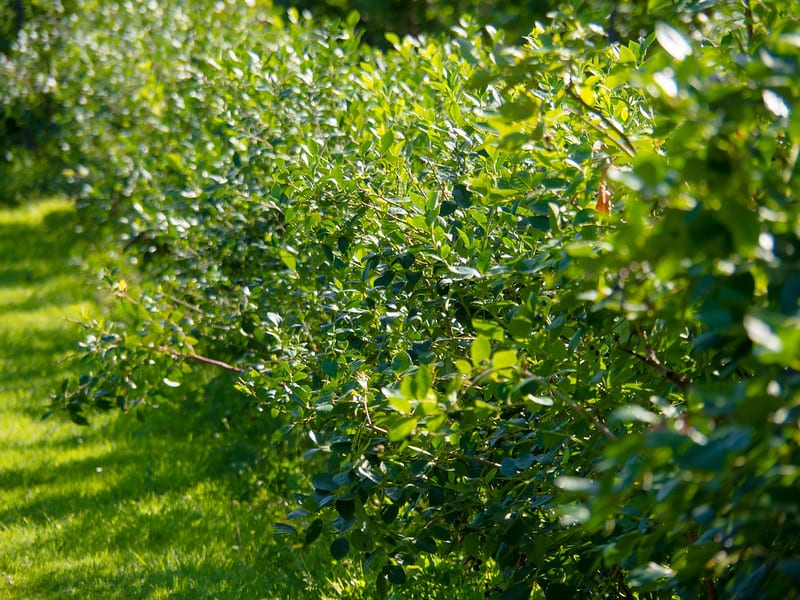
Harvesting Blueberries
Do not allow the bush to produce fruit for the first year or two after planting. This lets the plant use its energy to establish itself in its new home. Beyond that, blueberries are typically ready for picking between June and August.
Don’t rush to pick the berries as soon as they ripen into a blue color. Wait a couple of days. The berries should fall right into your hand when they are ready for picking.
Effective Watering Techniques
Growing blueberries from seed is an exciting process that requires precise care, particularly when it comes to watering. Getting the watering right from the seed stage through the development of the plant is crucial for your blueberries to flourish.
Understanding the Water Requirements
Blueberries from seed need consistent moisture to sprout and grow strong. It’s particularly important to keep the soil moist during the initial stages of growth to encourage germination. However, it’s just as crucial to avoid overwatering, which can harm your young blueberries from seed by promoting root diseases.
Setting Up Your Watering System
Installing a drip irrigation system can be a game changer for growing blueberries from seed. This system slowly drips water directly to the soil at the base of your plants, ensuring that the roots of the blueberries from seed receive the right amount of moisture without waste through evaporation.
How Often to Water
The right watering frequency for blueberries from seed depends mostly on your soil type and the weather. It’s usually best to water early in the morning. This timing helps reduce water loss to evaporation and gives the plants time to dry out a bit before the cooler evening hours, which can help prevent diseases.
During the initial germination phase, aim to keep the top layer of soil moist but not drenched. As your blueberries from seed grow into seedlings, you can start to water less frequently, which encourages the roots to grow deeper into the soil.
Checking Soil Moisture
For those growing blueberries from seed, keeping an eye on the soil moisture is key. A simple soil moisture meter can help you check if you’re maintaining the right moisture level around your blueberries from seed. Try to keep the soil moist to the touch, but not so wet that it clumps together.
By carefully managing how you water your blueberries from seed, you’ll help ensure they grow up healthy and ready to produce delicious fruit. Regular checks and adjustments to your watering routine are essential as your blueberries from seed develop into mature plants.
Pest and Disease Management
Successfully growing blueberries from seed requires vigilant pest and disease management. Whether you’re a novice or a seasoned gardener, understanding how to protect your developing blueberries from seed against common threats is crucial. This section covers essential strategies to keep your blueberry seedlings healthy and thriving.
Identifying Common Pests
Blueberries from seed are susceptible to various pests that can hinder their growth. Some of the most common pests include aphids, spider mites, and fruit worms. These pests can be particularly detrimental during the early stages of a blueberry plant’s life.
Regularly inspecting your blueberries from seed for signs of pests is the first step in effective management. Look for discolored leaves, sticky residues, or visible bugs on the underside of leaves.
Controlling Pests Naturally
For those growing blueberries from seed, using natural pest control methods can be a safe and effective strategy. Introducing beneficial insects like ladybugs or lacewings can help control aphid populations. Another option is to use neem oil, a natural pesticide that’s safe for blueberries from seed and effective against a variety of pests. Applying these treatments early in the morning or late in the evening can maximize their effectiveness and minimize harm to beneficial insects.
Managing Common Diseases
Diseases like powdery mildew, botrytis blight, and rust can also pose significant risks to blueberries from seed. These diseases often manifest as spots on leaves or fruit, wilting, and stunted growth. To manage these diseases, ensure your planting site has good air circulation and avoid overhead watering to keep foliage dry.
Preventative Measures
Preventive measures are vital when growing blueberries from seed. Ensure your soil is well-draining to avoid waterlogging, which can encourage root diseases. Crop rotation and cleaning up plant debris around your blueberries from seed can also reduce disease risks. If diseases are spotted early, removing affected plant parts can prevent further spread.
By diligently monitoring and addressing these challenges, you can help ensure that your blueberries from seed grow into robust, healthy plants. Regular checks, combined with appropriate preventative and responsive actions, are key to successful blueberry cultivation from seed.
Soil Preparation and Maintenance
Growing blueberries from seed requires well-prepared soil to ensure the health and productivity of your plants. Proper soil preparation not only supports the initial stages of growth but also contributes to the long-term success of your blueberries from seed.
This section provides essential tips on preparing and maintaining the ideal soil environment for your blueberries.
Preparing the Perfect Soil Mix
Blueberries from seed thrive in acidic soil with a pH level between 4.5 and 5.5. To achieve this, you’ll need to amend your garden soil before planting. Start by testing your soil’s pH; if it’s higher than 5.5, incorporate elemental sulfur or organic matter such as pine needles or peat moss to lower it. These amendments should be worked into the soil a few months before planting your blueberries from seed to allow the pH to adjust.
Enhancing Soil Structure
The ideal soil for blueberries from seed is well-draining yet retains moisture—a balance that can be achieved by adding organic matter. Compost, leaf mold, and well-rotted sawdust can improve soil structure, enhance water retention, and provide essential nutrients. Mix these materials into your soil to a depth of 12 to 18 inches to create an optimal growing environment for blueberries from seed.
Maintaining Soil Health
Once your blueberries from seed are planted, ongoing soil maintenance is key to sustaining their growth and fruit production. Regularly adding organic mulches such as pine bark or straw can help maintain soil moisture, suppress weeds, and keep soil temperatures stable. As these mulches decompose, they continue to enrich the soil with organic matter, maintaining the acidity that blueberries from seed need.
Monitoring and Adjusting Soil Conditions
It’s important to regularly monitor the soil conditions around your blueberries from seed. Re-test the soil pH annually, and adjust your soil amendments as needed to keep it within the ideal range for blueberries. Also, watch for signs of nutrient deficiencies—yellowing leaves may indicate a lack of iron or magnesium, common in soils that aren’t acidic enough.
By following these guidelines, you can create and maintain the perfect soil conditions for your blueberries from seed. Proper preparation and ongoing care will help your blueberry plants flourish, yielding delicious fruit for years to come.
Conclusion
Growing blueberries from seed requires patience and attention to detail in soil preparation, watering, and pest management. Each step, from planting to harvesting, plays a crucial role in the development of healthy, fruitful plants. By embracing these practices, gardeners can enjoy the rewards of nurturing blueberries to delicious maturity.
Apart from blueberries, there are many more fruits you can grow at home. Check out our easy fruits to grow in your garden post!








